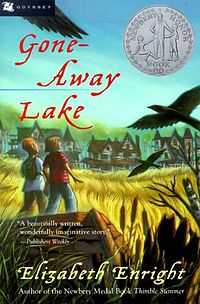Gone-Away Lake
| Gone-Away Lake | |
|---|---|
 Cover of Gone-Away Lake | |
| Author | Elizabeth Enright |
| Illustrator | Joe and Beth Krush |
| Country | United States |
| Language | English |
| Genre | Children's novel |
| Publisher | Harcourt Brace & Co. |
Publication date | 1957 |
| Media type | Print (Hardback & Paperback), Audiobook |
| Pages | 272 |
| ISBN | 0-15-202272-4 |
| OCLC | 42736382 |
| LC Class | PZ7.E724 Go 2000 |
| Followed by | Return to Gone-Away |
Gone-Away Lake is a 1958 Newbery Honor winning children's book by Elizabeth Enright. It received the Lewis Carroll Shelf Award in 1970. Gone-Away Lake tells the story of cousins who spend a summer exploring and discover a lost lake and the two people who still live there.
Plot
Gone-Away Lake opens on a train traveling through the countryside of western New York state. Ten-year-old Portia Blake and her six-year-old brother Foster are going to see their favorite cousin, enthusiastic amateur naturalist Julian Jarman. The Jarmans have recently purchased a house in the country. Once there, Portia and Julian spend their days exploring, and one day they discover an abandoned Victorian resort community next to a bog. Elderly siblings Mr. Payton and Mrs. Cheever, the town's only remaining inhabitants, soon become friends with the children, who set up a club in one of the empty houses.
Stories of the days when the bog was a lake called Tarrigo are interspersed with the modern-day adventures of Portia and Julian, who at first keep the lake and their new friends a secret. Foster soon discovers the secret and eventually the rest of the Jarman and Blake families also become acquainted with the charms of Gone-Away and its inhabitants. In Return to Gone-Away, a sequel published in 1961, the Blake family buys and restores a house at Gone-Away.
Awards, reception
Gone-Away Lake was a Newbery Honor book in 1958.[1] It received the New York Herald Tribune's Children's Spring Book Festival Award in 1957.[2] In 1963 the American Library Association named Gone-Away Lake as the U.S. nominee for the international Hans Christian Andersen Award, and in 1970 it received the Lewis Carroll Shelf Award.[3]
Reviewers then and now praise Enright's excellent characterization, her use of description, and strong presentation of setting and nature in Gone-Away Lake. Irene Haas' review mentioned that "Animals abound, and secrets and clubs, danger and daring…"[4] According to Saturday Review, Enright "knows how to create real children".[2] Writer and reviewer Anita Silvey calls Gone-Away Lake "Enright's finest achievement." Silvey goes on to praise "Her descriptive powers and unique ability to observe the world through the eyes of a child..."[5] Children's book expert May Hill Arbuthnot also praised Enright's fine use of description, reminding the reader that "Good prose style for any age level surprises and delights."[6]
See also
World of the League of Extraordinary Gentleman
References
- ↑ "Newbery Awards". Retrieved 2012-05-15.
- ↑ 2.0 2.1 "Books for Young People". Saturday Review. Retrieved 2012-05-15.
- ↑ "Gone-Away Lake". Lewis Carroll Shelf Award. Retrieved 5/2/2012.
- ↑ Chevalier, Tracy (editor), Twentieth-Century Children's Writers, St. James Press, 1989, pp. 318;
- ↑ Silvey, Anita, The Essential Guide to Children's Books and Their Creators, Houghton Mifflin, 2002, pg. 143;
- ↑ Arbuthnot, May Hill, Children and Books, Scott, Foresman, 1964, pg. 19;
External links
"Top 100 Children’s Novels # 63". School Library Journal. Retrieved 2012-05-20.